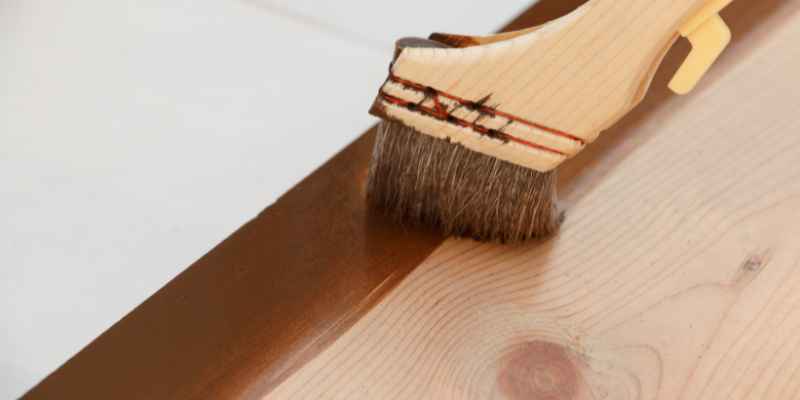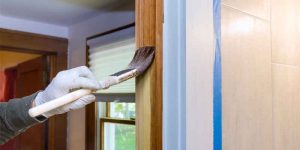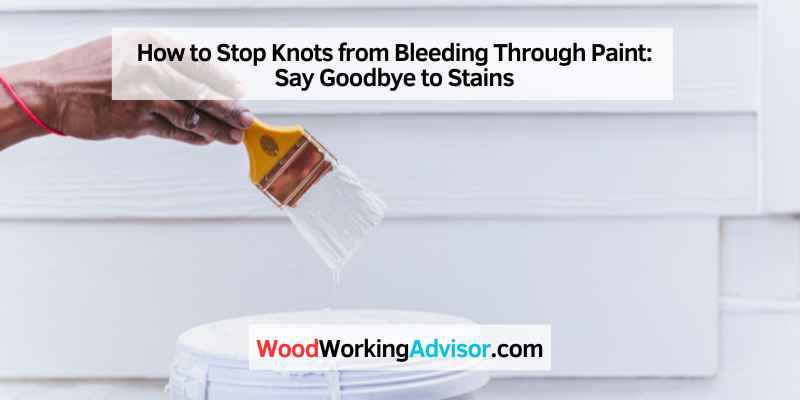To stop knots from bleeding through paint, apply a spot primer to the knots and follow up with a stain-blocking primer before painting. This will prevent the resinous compounds in pine knots from seeping through the paint and staining it.
Additionally, lightly sanding the knot and applying a coat of shellac or aluminum-based primer can also seal the resin away. If you have experienced knots bleeding through paint and ruining your work, this can be frustrating. Fortunately, there are effective ways to prevent this.
By using spot and stain-blocking primers, you can stop the resin from pine knots from ruining the finished product and ensure that your paint job looks professional. Read on to learn more about the best ways to stop knots from bleeding through paint.
Reasons For Knots Bleeding Through Paint
To prevent knots from bleeding through paint, it’s important to spot prime the knots first using a stain-blocking primer. Applying a coat of shellac or an aluminum-based primer can also effectively seal the resin in knots away and prevent bleeding through.
Sanding lightly between each coat can help achieve better results.
Reasons for Knots Bleeding Through Paint
Knots and resinous compounds go hand in hand, and when it comes to painting them, the process can be quite challenging. Resinous compounds are naturally present in trees and the timber produced from them. When a knot is exposed to heat or is cut, it can seep out resin which, if not sealed, can bleed through paint.
Unsealed knots have air pockets that can release resin and cause paint to flake and peel. To prevent this from happening, you must seal the knots before painting. Let’s take a closer look at the reasons for knots bleeding through paint.
Resinous Compounds
The resinous compounds that many knots contain are capable of seeping through the paint and staining it. They need to be adequately sealed before painting so that they cannot bleed through. To do this effectively, you should lightly sand the knot and apply a coat of shellac or one of an aluminum-based primer to seal the resin away so it can’t bleed through. Shellac-based primers are excellent for sealing wood knots and sap streaks. They dry very quickly, do not let the knot bleed through the topcoat, and are great if you’re in a rush.
Unsealed Knots
Unsealed knots have air pockets that can release resin and cause paint to flake and peel. When a knot is cut, it often contains air pockets that are easily exposed to the elements. If these air pockets are not filled with a suitable sealant, then they will continue to release resin, which can lead to the bleeding of paint. Caulk is a great solution for sealing knots. If you have already painted over an unsealed knot and are experiencing bleeding, you can spot-prime the area or use a stain-blocking primer before painting to prevent the stain from re-emerging.
In conclusion, knowing how to prevent knots from bleeding through paint is essential for achieving a professional finish on any wooden surface. Make sure to seal all knots with an appropriate sealant to prevent unsightly stains from seeping through your paint. By using shellac-based primers or spot-priming, you can effectively prevent knots from bleeding through paint and enjoy long-lasting and beautiful results.
Best Primers For Blocking Knots
Stop knots from bleeding through paint with the best primers for the job. Use stain-blocking primers like shellac-based primers or knotting solution to seal the resinous compounds in the knots, preventing them from seeping through the paint.
Best Primers for Blocking Knots
Knots in the wood can be a nuisance, especially when it comes to painting the wood. The resinous compounds in knots can seep through the paint and stain it, resulting in a not-so-appealing look. To prevent this, the knots must be properly sealed before they are painted. One way to do this is by lightly sanding the knot and applying a coat of primer. Here are some of the best primers for blocking knots.
Shellac-based Primer
Shellac-based primers are widely used for sealing wood knots and sap streaks. They have a pungent smell but dry quickly and do not let the knot bleed through the topcoat. Shellac-based primers are also effective at blocking water and smoke stains. Additionally, they work well on high-tannin woods like cedar and redwood. Take note that shellac-based primers are not recommended for outdoor use as they can break down when exposed to the elements.
Aluminum-based Primer
Another effective primer for blocking knots is an aluminum-based primer. This primer is specifically designed to stop knots from bleeding through. Aluminum-based primers are ideal for use on exterior wood surfaces like decks and fences. They are also resistant to rust and corrosion, making them perfect for use in coastal areas. However, aluminum-based primers take longer to dry and have a shorter shelf life compared to shellac-based primers.
When choosing the best primer for blocking knots, consider the type of wood you are using and the environment it will be in. Both shellac-based and aluminum-based primers are effective at blocking knots, but they have their own advantages and disadvantages. By selecting the right primer for your project, you can achieve a smooth and professional-looking finish without having to worry about knots bleeding through the paint.
Preparation Before Painting
If you want to prevent knots from bleeding through paint, it’s important to properly seal them beforehand. This can be done by spot priming or applying a stain blocking primer specifically designed for this purpose. Sanding down the knot and using shellac or an aluminum based primer can also help seal the resin away and prevent it from bleeding through the paint.
Spot Priming With Kilz Or Coverstain Primer
The best way to prevent knots from bleeding through paint is to spot prime them with Kilz or Coverstain primer. These primers help to seal the knot and prevent the resin from seeping through the paint. Apply the primer directly to the knots, and make sure to cover them completely. Once the primer has dried, give the surface a light sanding to remove any bumps or rough spots before painting.
Sanding Knot Areas
Before spot priming, ensure to sand the knot areas lightly to create a smooth surface for the primer. This will help to ensure that the primer adheres correctly and doesn’t flake off later. Use a 120-grit sandpaper to sand the knots gently and remove any loose fibers or flakes. Make sure to remove all sanding dust from the surface before applying any primer or paint.
If the knots are particularly large or have a lot of resin, then it’s essential to use an aluminum-based primer. These primers help to seal the resin and prevent bleed-through better than others.
To prepare bare wood for painting or staining, it is also essential to use a wood conditioner. This helps to seal the wood pores and create a smooth surface for the paint or stain to adhere properly and provide even coverage.
In conclusion, it is essential to take preparation steps before painting to stop knots from bleeding through paint. Spot priming with Kilz or Coverstain primer, sanding knot areas, and using wood conditioner can help to prevent bleed-through and ensure a smooth, even finish.
Solutions For Stopping Knots From Bleeding Through Paint
Preventing knots from bleeding through paint can be achieved by applying a knotting solution or sealing it with a stain-blocking primer. Lightly sanding the knot and using shellac or aluminum-based primer can also stop resinous compounds from causing bleed-through. Properly sealing knots before painting can ensure a flawless finish.
Knots in wood can be a persistent problem for painters. The resin often found in knots can seep through paint and ruin the finished product. Luckily, there are solutions to this issue. In this post, we will cover three ways to stop knots from bleeding through paint. These solutions include applying knotting solution, applying stain blocking primer, and using heated paint remover.
Applying Knotting Solution
Knotting solution is a type of sealant that is specifically designed to stop knots from bleeding through paint. The solution is applied directly to the knot and left to dry before painting. To apply knotting solution, you will need a paintbrush and a well-ventilated area.
1. Start by cleaning the knot with a piece of sandpaper or a wire brush to remove any loose wood fibers.
2. Apply the knotting solution generously to the knot with a paintbrush.
3. Allow the solution to dry completely before continuing with painting.
Applying Stain Blocking Primer
Stain blocking primer is another effective solution for preventing knots from bleeding through paint. This type of primer works by sealing the knot and preventing any resin from seeping through.
1. Start by cleaning the knot with a piece of sandpaper or a wire brush to remove any loose wood fibers.
2. Apply the stain blocking primer to the knot with a paintbrush. Be sure to apply it generously to ensure complete coverage.
3. Allow the primer to dry completely before continuing with painting.
Heated Paint Remover
If you have already painted over the knot and are experiencing bleed-through, a heated paint remover may be your best option. This method involves using a hot air gun to heat the paint and remove it from the surface of the wood. This can be a time-consuming process and should only be used if other methods have failed.
1. Start by heating the paint in the affected area with a hot air gun.
2. Use a scraper to remove the softened paint.
3. Repeat steps one and two until all of the paint has been removed from the knot.
4. Clean the area with sandpaper or a wire brush to remove any remaining residue.
5. Apply knotting solution or stain blocking primer to the knot before continuing with painting.
In conclusion, stopping knots from bleeding through paint is essential for achieving a professional-looking finished product. By applying knotting solution, stain blocking primer, or using heated paint remover, you can effectively seal knots and prevent bleed-through. Remember to clean the knot before applying any solution or primer, and always allow the products to dry completely before continuing with painting.
Application Of Paint

Prevent knots from bleeding through paint on pine wood by spot-priming the knots first. After that, apply a stain-blocking primer on the entire surface and check for missed knots before painting the final coat. Alternatively, you can seal the knot with shellac or aluminum-based primer to prevent resinous compounds from seeping through the paint.
Applying Trim Paint
When applying paint to trim, it’s important to use a high-quality paintbrush that is specifically designed for trim work. To prevent knots from bleeding through the trim paint, it is recommended to use a shellac-based primer before applying the topcoat. If you’re repainting an already-painted surface, be sure to scrape and sand any existing paint to ensure a smooth surface before applying the primer.
Number Of Coats Required
Depending on the severity of the knot bleeding, you may need to apply multiple coats of primer before applying the topcoat to completely seal the knots. It’s important to note that applying multiple coats of primer or topcoat too quickly can result in the paint not drying properly and can cause paint failure. It’s best to follow the manufacturer’s instructions for drying times between coats.
To summarize, while applying paint to the knots is one way to try to prevent bleeding, the application of a shellac-based primer is the most effective method. It may take multiple coats of primer and topcoat to completely seal the knots, but it will be worth it in the long run to prevent unsightly bleeding. Remember, proper surface preparation is also key to achieving a successful paint job.
Long-term Results
Prevent knots in pine from bleeding through your paint by spot priming them with a stain-blocking primer or applying a knotting solution. Sand the knots lightly and seal them with shellac or aluminum-based primer for long-term results that won’t show knots on painted wood.
Follow these tips to make sure your wood stays knot-free and perfectly painted.
Effectiveness Of Different Solutions
When it comes to preventing knots from bleeding through paint, there are multiple solutions available. Some common solutions include spot priming the knots, applying a stain-blocking primer, and using knotting solution. All of these solutions are effective at sealing the knots, but the most effective solution may vary depending on the type of wood and the severity of the knot bleed.
Factors Affecting The Outcome
Several factors can affect the outcome of applying knot sealers while painting. One of the most significant factors is the type of wood used. For instance, pine wood tends to have more knots than other varieties of wood. The age of the wood and its porosity can also affect the outcome. Moreover, following the manufacturer’s instructions can also ensure better results.
Using knot sealer solutions will provide long-term results. For the best results, it is recommended to wait for a full day so that the sealant can dry completely before painting. This not only prevents the knots from bleeding through the painted surface but also increases the durability and life of the paint. Additionally, it helps in protecting the wood from damage and moisture, thus providing a long-lasting finish. Overall, using knot sealers is a reliable and easy way to prevent knots from bleeding through the paint, creating a smooth and beautiful finish.

Frequently Asked Questions For How To Stop Knots From Bleeding Through Paint
How Do You Seal A Knot Before Painting?
To seal a knot before painting, lightly sand it and apply a coat of shellac or an aluminum-based primer to seal away the resin and prevent bleeding. Use a shellac-based primer for the best results. Make sure to spot prime or apply a stain-blocking primer to the knots and check for missed knots before applying the topcoat.
How Do You Fix Wood Bleeding Through Paint?
To prevent knots from bleeding through paint, lightly sand the knot and seal it with shellac or aluminum-based primer before painting. Apply a spot primer or stain-blocking primer, or use knotting solution to ensure proper coverage. Use a shellac-based primer to block wood knots and sap streaks and apply three coats for long-term results.
A heated paint remover can be used in some cases, but always ensure that the knot is completely dry before painting.
Why Do Knots In Wood Come Through Paint?
Knots in wood contain resinous compounds that can seep through paint, causing them to be visible. To prevent this, it’s necessary to lightly sand the knot and apply either shellac or an aluminum-based primer to seal the resin. Shellac-based primers are great for blocking wood knots and sap streaks.
What Is The Best Primer For Blocking Wood Knots?
The best primer for blocking wood knots is a shellac-based primer. It effectively seals the resin in knots and prevents bleed through. Use a stain blocking solution on knots before painting for optimal results. Avoid paint and stains without proper sealing.
Conclusion
To sum it up, knots in wood can be a challenging issue to deal with when it comes to painting. However, there are effective ways to prevent knots from bleeding through paint and ruining the overall finish. Properly spot priming the knots, applying a stain blocking primer, and using knotting solution are just a few ways to ensure beautiful and long-lasting results.
So armed with these techniques, you can now confidently take on any painting project without worrying about knots showing through the paint.


